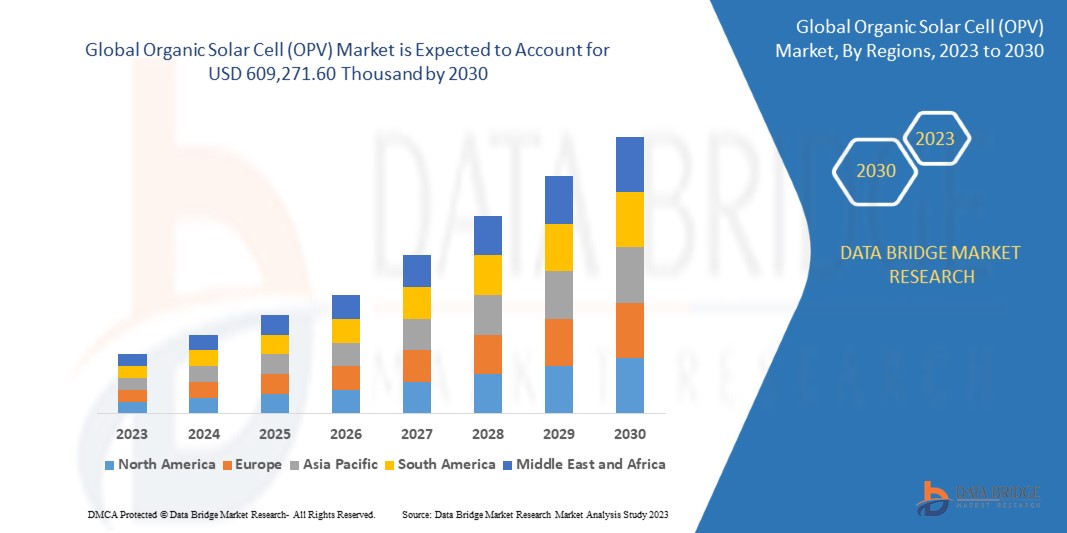
Organic Solar Cell (OPV) Market Performance | Market Share, Size, and Competitive Insights 2025 - 2032
The Organic Solar Cell (OPV) Market is undergoing a significant transformation, with industry forecasts predicting rapid expansion and cutting-edge technological innovations by 2032. As businesses continue to embrace digital advancements and strategic shifts, the sector is set to experience unprecedented growth, driven by rising demand, market expansion, and evolving industry trends.
A recent in-depth market analysis sheds light on key factors propelling the Organic Solar Cell (OPV) market forward, including increasing market share, dynamic segmentation, and evolving consumer preferences. The study delves into crucial growth drivers, offering a detailed outlook on industry progress and future potential. Additionally, the report leverages SWOT and PESTEL analyses to assess market strengths, weaknesses, opportunities, and threats while examining economic, regulatory, and technological influences shaping the industry's trajectory.
DataBridge Market Research has newly launched the NUCLEUS Platform, a Cloud-Connected Intelligence Platform that allows users to analyze and integrate macro and micro-level data seamlessly. This revolutionary tool bridges the gap between data analytics, market research, and strategy, providing businesses with a fully automated, Interactive Dashboard with Real Time Updates throughout the Year to drive profound growth and revenue impact.
Competitive intelligence plays a pivotal role in this sector's evolution, with leading companies innovating and expanding across key regions. The latest market insights provide a comprehensive overview of emerging opportunities, investment hotspots, and strategic business approaches.

For businesses and investors looking to stay ahead in the Organic Solar Cell (OPV) market, this report serves as a vital resource, offering data-driven insights and strategic recommendations to navigate market challenges and capitalize on future growth opportunities. As 2032 approaches, staying informed about industry trends and leveraging intelligent market platforms like NUCLEUS will be crucial for maintaining a competitive edge in this fast-evolving landscape.
What is the projected market size & growth rate of the Organic Solar Cell (OPV) Market?
Market Analysis and Size
The global organic solar cell (OPV) market is expected to grow significantly in the forecast period of 2023 to 2030. Data Bridge Market Research analyses that the market is growing with a CAGR of 10.9% in the forecast period of 2023 to 2030 and is expected to reach USD 609,271.60 thousand by 2030. The major factor driving the growth of the organic solar cell (OPV) market is the rising popularity of organic solar cell (OPV) products among the organic solar cell and growing awareness regarding the properties of the organic solar cell (OPV) products.


Organic solar cells (OSCs), which are categorized as third-generation solar cells using organic polymer material as the light-absorbing layer, are one of the newest photovoltaic (PV) technologies. Organic photovoltaic (OPV) solar cells seek to offer a low-energy-production and earth-abundant photovoltaic (PV) solution.
The global organic solar cell (OPV) market report provides details of market share, new developments, and the impact of domestic and localized market players, analyses opportunities in terms of emerging revenue pockets, changes in market regulations, products approvals, strategic decisions, product launches, geographic expansions, and technological innovations in the market. To understand the analysis and the market scenario, contact us for an analyst brief. Our team will help you create a revenue-impact solution to achieve your desired goal.
| Report Metric | Details |
|---|---|
| Forecast Period | 2023 to 2030 |
| Base Year | 2022 |
| Historic Years | 2021 (Customizable to 2020 - 2015) |
| Quantitative Units | Revenue in USD Thousand |
| Segments Covered | By Type (Bilayer Membrane Heterojunction, Schottky Type, and Others), Material (Polymer and Small Molecules), Application (BIPV & Architecture, Consumer Electronics, Wearable Devices, Automotive, Military & Device, and Others), Physical Size (More Than 140100 MM Square, and Less Than 140100 MM Square), End User (Commercial, Industrial, Residential, and Others) |
| Countries Covered | U.S., Canada, Mexico, Germany, France, U.K., Italy, Russia, Spain, Netherlands, Belgium, Switzerland, Turkey, and the Rest of Europe. Japan, China, South Korea, India, Singapore, Thailand, Indonesia, Malaysia, Philippines, Australia, and the Rest of Asia-Pacific, Brazil, Argentina, and the Rest of South America, South Africa, Egypt, Saudi Arabia, U.A.E, Israel, and the Rest of the Middle East and Africa. |
| Market Players Covered | Eni S.p.A, TOSHIBA CORPORATION, ARMOR, Tokyo Chemicals Industry Co. Ltd, Merck KGaA, Alfa Aesar, Thermo Fisher Scientific, Heliatek, Solarmer Energy Inc., SUNEW, Epishine, Lumtec, Borun New Material Technology Co., Ltd, Novaled GmbH, Ningbo Polycrown Solar Tech Co, Ltd, SHIFENG TECHNOLOGY CO., LTD., Solaris Chem Inc., MORESCO Corporation, NanoFlex Power Corporation, and Flask, among others |
Market Definition
Organic solar cells or organic photovoltaics refer to multilayer photovoltaic devices made with organic compounds, converting solar energy into electricity. An organic solar cell is manufactured using carbon-based material and organic electronics instead of silicon as a semiconductor. Organic cells may also be referred to as plastic solar cells or polymer solar cells; compared to crystalline silicon solar cells, organic solar cells are made from compounds that can be dissolved in ink and printed onto plastics. This gives the organic solar cells the attribute of flexibility, lightweight and easy incorporation in places or structures, among others.
Organic solar cell technology is still developing. The power conversion efficiency of the organic solar cell does not match the efficiencies achieved by inorganic silicon solar cells. But the OPVs showcase a wide range of potential applications, and it might not be long before they become the commonly used technology. OPVs are easy to manufacture compared to inorganic solar cells and cheap to produce, and physically versatile. The working principle of organic solar cells is just like that of monocrystalline and polycrystalline silicon solar cells. They generate electricity through the photovoltaic effect in three simple steps, such as:
Electrons are knocked loose from the semiconducting polymer material when light is absorbed